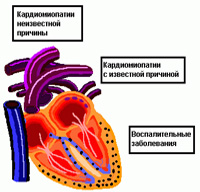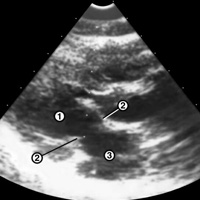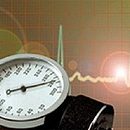The basis of restrictive cardiomyopathy is a significant reduction in the extensibility of myocardium and as a result of the insufficiency of the blood flow of the heart with the subsequent development of chronic heart failure.
Content
Restrictive cardiomyopathy
Restrictive cardiomyopathy (from Latin word restrictio «limitation») - a disease characterized by a pronounced decrease in myocardial extensibility due to various reasons, and accompanied by insufficient blood circulation with the subsequent development of chronic heart failure.
Causes of disease development
 The only proven cause of primary restrictive cardiomyopathy is the so-called hyperoeosinophilic syndrome distributed in countries with tropical climates. Eosinophils - blood cells involved in the development of inflammatory reactions, mostly allergic nature.
The only proven cause of primary restrictive cardiomyopathy is the so-called hyperoeosinophilic syndrome distributed in countries with tropical climates. Eosinophils - blood cells involved in the development of inflammatory reactions, mostly allergic nature.
With a hyperoeosinophile syndrome (lefball disease) occurs inflammation of endocardium - the inner sheath of the heart. Over time, this inflammation is completed by a significant compaction of the endocardium and its coarse pawing with a nearby myocardium, which leads to a sharp decrease in the extensibility of the heart muscle. In the overwhelming majority of cases, the origin of restrictive cardiomyopathy is secondary, that is, due to other reasons. Amyloidosis - a disease related to metabolic disorders in the body, in particular, protein metabolism. With amyloidosis, it is formed and deposited in the tissues of various organs in large quantities an abnormal protein (amyloid). With the defeat of the heart, this protein literally «Impreet» Myocardium, causing a significant reduction in its contractility and extensibility. Hemochromatosis - a rare disease in which iron exchange in the body is disturbed. The content of iron in the blood with hemochromatosis is increased, its excess is postponed in many organs and tissues, including in myocardium, causing a decrease in its extensibility. Sarcoidosis is a disease of unknown nature, characterized by the formation of special cellular clusters in organs and tissues (granulom). Most often occurs sarcoidosis of lungs, liver, lymph nodes and spleen.
Restrictive Cardiomyopathy Development Mechanism
The restriction of the exhalation of myocardium leads to a decrease in the filling of the ventricles with blood and a significant increase in intraventricular pressure. When restrictive cardiomyopathy, compensatory capabilities organism reduced. Consequently, after a while it is stagnant in a small (pulmonary) circle of blood circulation and a decrease in the pumping function of the heart. Gradually develop resistant edema of legs, hepatomegaly (increase in liver) and yawning of the abdomen (ascites) due to a fluid delay in the body due to a decrease in the pump function.
If the endocardium seal applies to valves (mitral and tricuspid), the state is aggravated by the development of their insufficiency. In the cavities of the heart due to their reduced contractility and extensibility, clomes can be formed. The spread of fragments of these blood flow thrombus (thromboembolism) can cause infarction of internal organs and blocking large vessels. During restrictive cardiomyopathy, various types of arrhythmias are also quite often observed.
The main manifestations of the disease
Restrictive cardiomyopathy patients usually complain about shortness of breath, first when performing physical exertion (running, fast walking and t.D.), and as the disease progressing and alone. Due to the reduction of the pumping function of the heart, a typical complaint is fast fatigue and bad tolerability of any physical exertion. Then join the edema of the legs, the increase in the liver and the stomach water. Periodically, patients complain about the neurotic heartbeat. When developing persistent blockads, a trimming state may occur.
Restrictive cardiomyopathy diagnostic methods
 Echocardiographic study is one of the most informative methods of diagnosing the disease. It allows you to identify the thickening of the endocardium, changing the nature of the filling of the ventricles of the heart, reducing the pump function of the heart and the presence of valve deficiency. Magnetic-resonant tomography - a method that allows you to obtain information about the anatomy of the heart using a special computer processing, to identify pathological inclusions in myocardium and measure the endocardium thickness. Heart probing is usually performed for measuring pressure in the cavities of the heart and detection characteristic of this disease. Conducting this study is necessary in controversial cases, in particular, to eliminate the disease of the outer shell of the heart (pericardium) - constrictive pericarditis.
Echocardiographic study is one of the most informative methods of diagnosing the disease. It allows you to identify the thickening of the endocardium, changing the nature of the filling of the ventricles of the heart, reducing the pump function of the heart and the presence of valve deficiency. Magnetic-resonant tomography - a method that allows you to obtain information about the anatomy of the heart using a special computer processing, to identify pathological inclusions in myocardium and measure the endocardium thickness. Heart probing is usually performed for measuring pressure in the cavities of the heart and detection characteristic of this disease. Conducting this study is necessary in controversial cases, in particular, to eliminate the disease of the outer shell of the heart (pericardium) - constrictive pericarditis.
The lifetime biopsy of myocardium and endocardium is usually performed simultaneously with the probation of the heart. This method has the greatest informativeness to clarify the nature of the disease and further treatment. Since the damage to myocardium in some embodiments of restrictive cardiomyopathy, for example, during sarcoidosis, does not apply to all myocardium, the biopsy may not bring the desired success. This is explained by the fact that when taking a biopsy, the doctor technically cannot see directly myocardium. Therefore, the modified portion of myocardium may not fall into the number of samples of the heart tissue, selected for further microscopic examination. In extremely rare cases, when the above diagnostic methods do not allow you to accurately diagnose, the direct audit of the pericardium on the operating table is carried out. All patients with restrictive cardiomyopathy needed a comprehensive clinical and biochemical and additional examination to identify the extraimatic causes of the disease, in particular, amyloidosis and hemochromatosis.
Principles of treatment of restrictive cardiomyopathy
Treatment of the disease is pretty difficult. In some cases, diuretic drugs (aldakton, in particular) can be used to eliminate excess fluid in the body. Most of the medicines commonly used to treat heart failure, are little effective. This is due to the fact that due to the characteristics of the disease, it is impossible to achieve a significant improvement in the extensibility of myocardium (sometimes calcium ion antagonists are prescribed for these purposes). To eliminate persistent conductivity disorders, it may be necessary to formulate (implantation) of a permanent electrocardiotimulator. Diseases such as sarcoidosis and hemochromatosis are subject to independent treatment. Sarcoidosis is treated with hormonal preparations (prednisolone and others.), and hemochromatosis - regular bleeding (to reduce the content of iron in the body). The treatment of myocardium amyloidosis largely depends on the causes of the very amyloidosis. When thrombo formation in the heart chambers, it is necessary to appoint anticoagulant drugs.Surgical treatment is effective in cases of restrictive cardiomyopathy caused by the defeat of the endocardium. All modified endocardia. In some cases, when there is a deficiency of atreservant valves, their prosthetics are performed. Separate forms of amyloid lesions of myocardium are treated with heart transplantation.
Preventive measures under this disease are limited. Early detection of potentially disposable reasons for restrictive cardiomyopathy (amyloidosis, sarcoidosis, hemochromatosis, etc.). To achieve these goals, it may be useful to conduct annual population examination.









